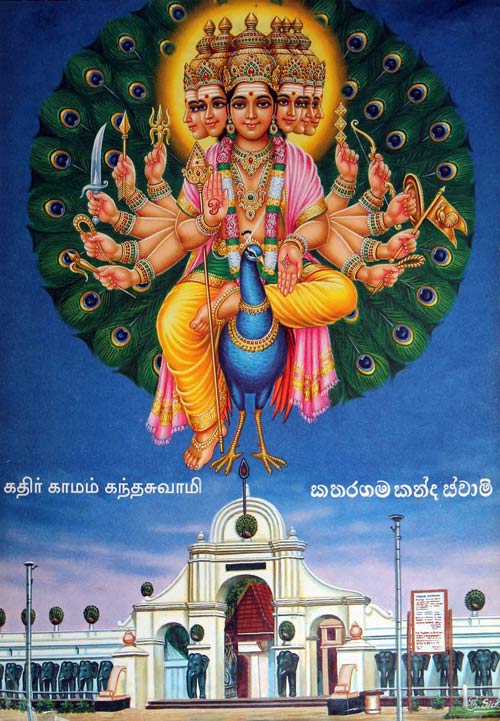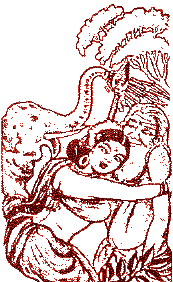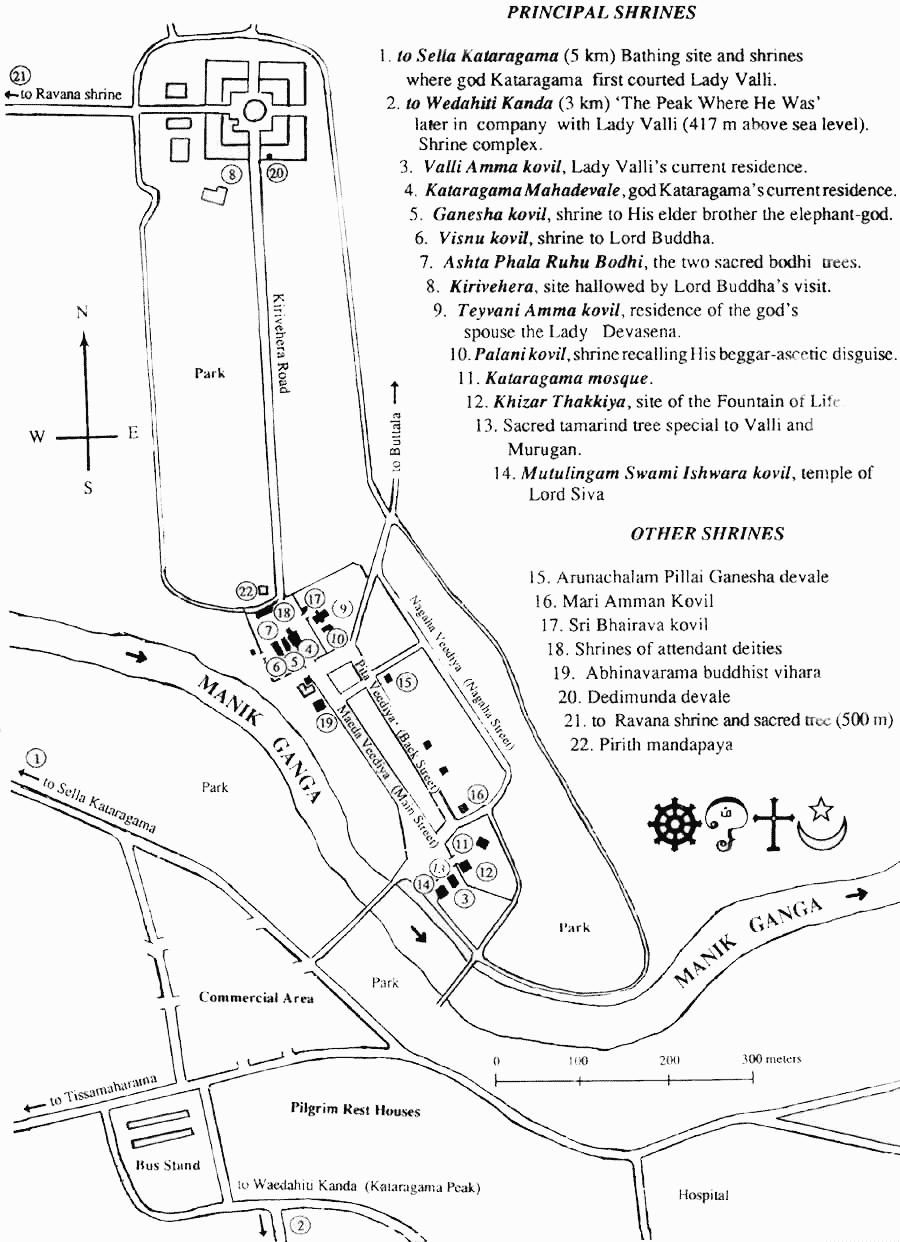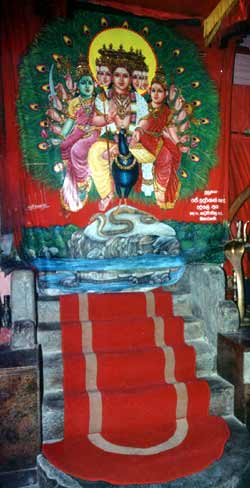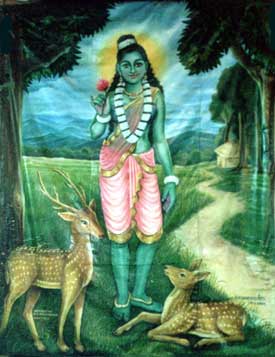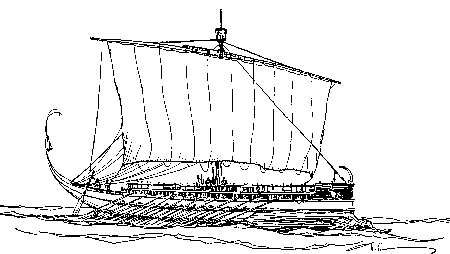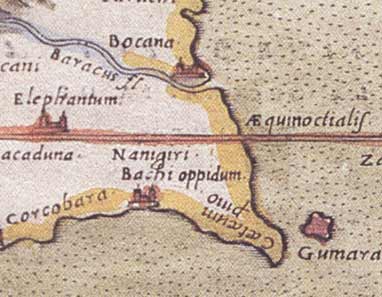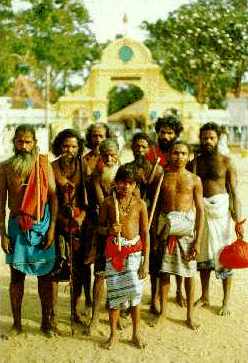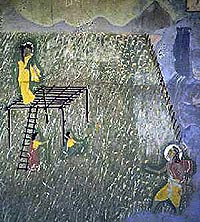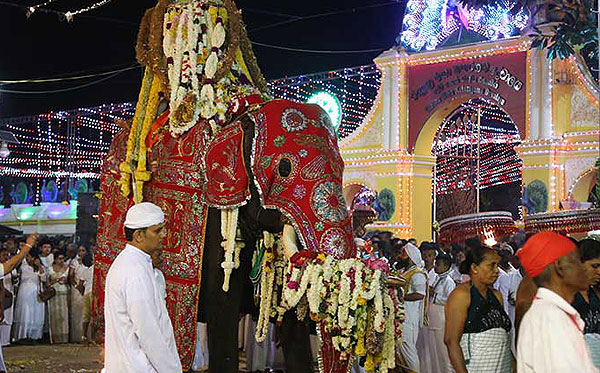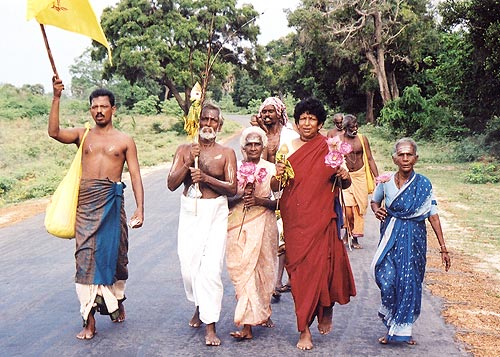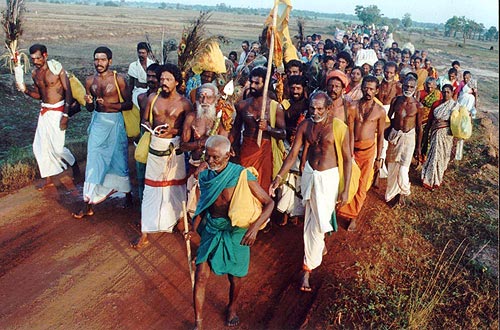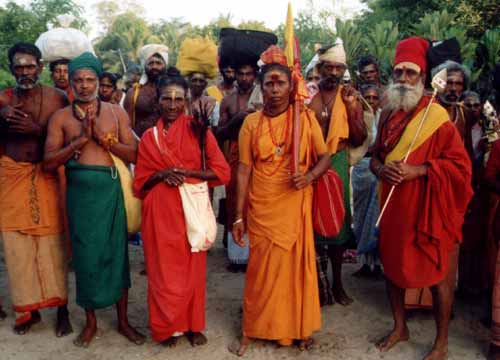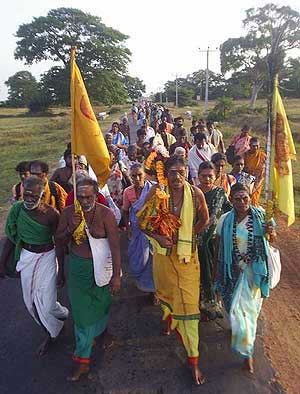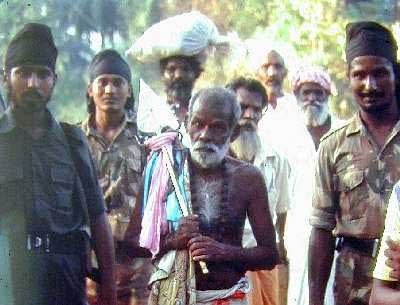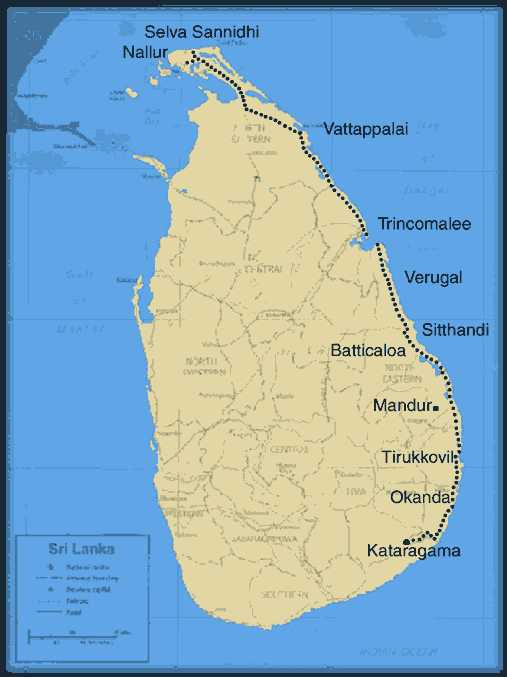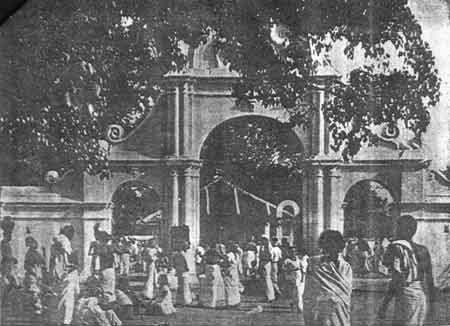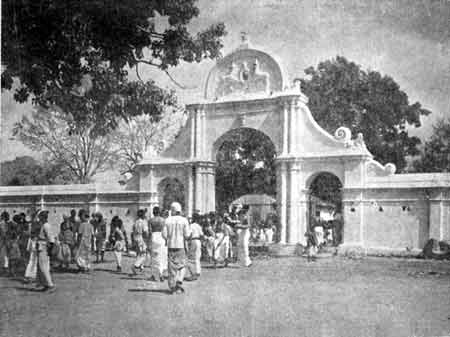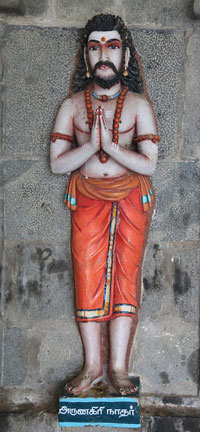|
| |||||||||||||||||||||||||||||||||||||
Kathirkāmam, the Abode of SkandaBy V.S. Krishnan and Patrick Harrigan
அருவமும் உருவும் ஆகி அநாதியாய்ப் பலவாய் ஒன்றாய்ப் பிரமமாய் நின்ற சோதிப் பிழம்பதோர் மேனியாகக் கருணைகூர் முகங்கள் ஆறும் கரங்கள் பன்னிரெண்டும் கொண்டே ஒருதிரு முருகன் வந்தாங்கு உதித்தனன் உலகம் உய்ய.
"He who is with form and without form, who has no beginning or end, who manifests as one and as many, who is the reflection of Brahman, the eternal reality, who originated as powerful flame of fire, whose six sacred faces full of grace and compassion whose twelve arms ever extending blessings, who manifested as the brilliant rays of the rising sun, He is Murugan, the Lord whom I worship." Kachiappa Sivāchāriyar’s immortal work Kanda Purānam opens with the above hymn. If devotees worshiping Kathirkāma Kanthan would happen to read these lines, they might be excused for assuming that the sage wrote these verses with Kathirkāma Kanthan specifically in mind, for every line of it is a true depiction of the Lord of Kathirkāmam. It only serves to highlight some startling differences that Indian pilgrims soon notice about Kathirkāmam. As the name Su-brahmanya indicates, Murugan is the reflection of Brahman and is normally worshiped with form. However, according to Advaita Vedanta, Brahman, the eternal reality, is without form. Arunagirinathar’s Kandar Anubhūti says: “He is with form and without form. He is and He is not.” (Uruvai, aruvai, ulathai ilathai) He appears as one and as many. He appears as Murugan. Though Murugan is described variously as Jñāna Paṇḍitā (Expositor of Wisdom), Lord of Compassion (Karuṇākara) and as Sovereign Lord (Swāminātha), in truth Murugan is indescribable and indefinable since He is without form, attributes (nirguna), beginning or end. He appears in Kathirkamam not as an icon or form (mūrti, ṡilā or vigraha) but as a presence experienced deep within one’s heart. According to Kanda Purānam, Murugan first appeared in the form a spark from the third eye of his father Siva. Once this spark was discharged at Saravana marsh, rays radiating from the spark illuminated Kathirkāmam in Sri Lanka as His ultimate goal. A Rogue and a Trickster
Names of ancient sacred places hold great significance and Kathirkāmam is no exception. The name kathir-kāmam consists of two words kathir (‘a ray’) plus kāma denoting longing and desire, often with a sexual connotation. Kathir-kāmam thus means ‘(the place of) illumination and earthly love’. Even today, Sri Lanka preserves in Kathirkāmam many archaic beliefs and practices that have long been lost throughout India. These traditions come broadly under the pre-Buddhist royal cult of maintaining justice and timely rains and fertility throughout the blessed island of Lankā. For instance, the tradition survives of a weekly offering to the Kataragama god of cooked venison or deer flesh, the Vedda folk's choicest offering, an ancient practice found nowhere in South India today. Stranger still, the Kataragama god is widely considered by Sri Lankans of all faiths to be a rogue and a trickster who likes to play pranks with believers and unbelievers alike. Among his staunch devotees are many unsavory characters, including criminals and politicians. This association of Skanda with rogues and criminals may be traced back to the Arthava Veda where in the Skanda Yāga section he is worshipped by thieves as their guru and is explicitly called dhūrta, which can only mean 'a rogue', associations which have survived solely in Sri Lanka for well over two thousand years. And yet, in spite of this, he is widely understood to be a loving and beneficent god who will grant anyone's wish or vow--so long as both parties keep their end of the bargain!
Temple complexDespite its far-reaching fame, the Kathirkamam temple is a remarkably humble structure that was until relatively recently situated in the midst of forbidding dry jungle. The main temple, or Ruhunu Mahā Kataragama Devālaya as it is known locally, is dedicated to Kathirkama Kanthan, the Lord of infinite beauty, power and compassion. Within this same small building complex one finds small temples for Ganesa, Visnu and also for Teyvanai and other minor deities. Eight hundred meters to the north is the ancient Buddhist stupa Kiri Vehera which is counted as one of the sixteen places in Sri Lanka visited by Lord Buddha. Two hundred meters south of the main temple complex, there is also the Muslim mosque and shrine immediately beside Valli Amman Kovil, which indicates how Kathirkamam is the confluence (sangamam) of all faiths. So important is the mosque that the festival cannot begin or end without the ceremonies of hosting (kotiyetrum) and lowering an Islamic flag. Islamic tradition holds that there is an invisible spring on that very spot associated both with al-Khiḍr, (the 'Green Man') and with Valli, who is similarly green and associated with plant life. Another unique feature of the temple is its link with Mount Kailāsa in western Tibet. A North-South meridian line drawn on the map from Mount Kailasa meets Kathirkamam in the far South. This same North-South axis is also an analogue to the Lord’s Vel as well as to the sushumna nadi of yogic lore, which also explains Kathirkama's designation as Dakshiṇa Kailāsa, the Southern Kailāsa, so important is this sacred forest in yogic lore since long before maps even existed. No account of Kathirkamam would be complete without mention of its well-deserved reputation for mystery and secrecy. Mysteries within mysteries surround Kathirkamam and its traditions. Devotees from far off places eagerly come here to seek His grace, but when they stand before the sanctum sanctorum, they see only seven tirai or curtains painted with the image of Skanda flanked by Valli and Teyvanai. The screens prompt the devotee to turn within so that his attention is fixed upon his own Self as the reflection of Murugan. The presiding kapurāla-priests, Sinhalese Buddhists who openly admit that their paramparā has come down to them from the indigenous Veddas before them, take the offering of the devotees, go inside, offer worship on behalf of the devotee and come back with the Lord’s prasādam. The worship is offered to the deity, whose Presence is widely believed to reside in a yantra or magical diagram etched upon a metal plate with the Omkara mantra inscribed on it. It is never displayed—nor is its existence either confirmed or denied. Even though the devotee finds no image of the deity, he experiences the presence of Murugan within and returns with a great sense of fulfilment and illumination. Legend of KathirkāmamThere are different Sri Lankan versions of how Kanthan came to accept Kathirkāmam as His abode. Indigenous Wanniyal-Aetto tradition has it that the Seven Hills (Tamil: Ēḻu malaikaḷ) of Kataragama are sacred to the great hunter god Kande Yaka who once lived there for a great long time. Greek mariners of the early Christian era sailed annually from Alexandria to the fabled island of Taprobane (Lanka) — and knew its coastal features well. The sea off of Kataragama was known to Alexandrian mariners as Dionysi Mare (Latin: 'The Sea of Dionysus'). The same Greeks mariner-informants called its town Dionysi seu Bacchi Oppidum—'The Town of Dionysus or Bacchus', the Greek name of the god of ritual theatre and ecstatic abandon—two enduring key features of Kataragama. Among those mariners were almost certainly some who were initiates into the Dionysian mysteries that were alive and popular in their times, making their identification of Kataragama with Dionysus entirely natural. Cultural anthropologist Agehananda Bharati observed in 1973 that Kataragama Skanda is a "Dionysian god"--so little has changed in 2,000 years. Both Sinhala and Tamil traditions agree that the Kataragama god first landed by sea in a stone boat at various places including Okanda, alone or with His associates, and walked to Kathirkāmam always keeping near to the the east coast. This is the origin of the Kathirkāma Karai Yāthirai or annual coastal foot pilgrimage.
Most all versions agree on the purpose of His one-way journey to Kathirkāmam. It was His affection for Valli, the adopted adolescent daughter of the chief of the local Vedda tribe of hunters. As a mere girl she had sworn to marry no man, but only the Veddas’ hunter-god himself and to allow no mortal man to come near her. Her girfriends teased her, but she was adamant. Valli, who was alone guarding a crop of millet growing in a jungle clearing, had been aspiring to marry Murugan ever since had heard of Him. Lord Murugan had also learned from sage Narada both the benign qualities of Valli and her whereabouts. Presenting the outward appearance of a handsome Vedda youth, the god boldly approached Valli and straightaway proposed to marry her. The girl, not recognizing who was standing before her, threatened to stone Him with her handy sling if He came any closer, so He had to withdraw and try another guise. So begins the timeless tale of the soul’s yearning to be united with her Lord.
More than a Pretty FaceIn contrast to the Lord’s grand celestial wedding to Teyvanai Amman, Valli's wedding was rustic and simple. Strange it may appear that Murugan, the Supreme Lord, who even acted as guru (Swaminātha) to his father Lord Siva, appeared to be infatuated by the poor innocent tribal girl, soliciting her favour and seeking her hand in marriage. Ancient Tamil Cankam poetry tells us that Lord Murugan suffered intense pangs of separation whenever He felt even the shortest separation from His beloved Valli! It is a classic illustration of who qualifies for Murugan’s grace. It is only one whose heart is full of devotion, whose thoughts are directed toward no one else but Murugan and whose simple quiet and austere life qualifies them for Murugan’s grace. The path adopted by Valli is regarded by pundits as Valli Sanmargam. Valli symbolized the qualities of detachment, dispassion, humility and love. She transcended her own individuality without entertaining the notion of a separate ‘I’. Today we often consider Valli as little more than a sweet and innocent tribal girl. And yet, she was also brilliant, possessing far more than a pretty face and figure. For from a very early age her attraction for the Veddas' hunter God of the Mountain prompted her to think outside the box, vowing to 'do the impossible' that no one had ever before even considered--and kept that 'impossible' vow. This is undoubtedly the origin of Kathirkāma Kanthan's reputation for granting 'impossible' wishes to those who keep their vows to Him. In his Kandar Alankaram beginning with the words, Kinnam Kurithu, Arunagirinathar explains this further. “Murugā! You have advised me that whoever worships Me without a sense of “I” (ego) becomes one with Me. Since Valli has lived the life that you advised for all, you went all out in search of her and after playing many divine sports, married her.” Valli Tirumaṇam is re-enacted today in order to highlight importance of Valli Sanmargam, the path of selflessness and purity followed by Valli. Whether the original encounter and marriage actually took place at Kathirkamam or in South India may continue to remain as a question. What is relevant and important is its message that when the individuality or the ‘I’ notion ceases, the Jivātma is merged in Paramātma. Kathirkamam has a long history which dates back several millennia. There are different theories about the origin of the temple. According to the records, it was the Sinhalese King Dutugamunu (reigned from 161 to 137 BCE) who renovated the temple and its traditions that had already existed long before his time. He did this as a mark of gratitude to Murugan for the blessing he received in restoring his kingdom back from invaders. Mode of WorshipIn most of the temples associated with Kathirkamam, one finds the Vel (lance) alone worshiped as the predominant form of His worship. Rather than an icon of Murugan, it is the Vel, an aniconic representation of Skanda-Murugan, that is venerated and worshipped. Vel worship constitutes one of the unique features of temples in Sri Lanka, especially in Eastern and northern regions where Tamils live in large number. The root word vel comes from velluthal which means victory and Vel symbolizes victory over evil forces. The Vel held by Murugan is also known as Kathir Vel as it radiates brilliant rays of insight (jñānam). Arunagirinathar’s Vel Vakuppu describes the power of Murugan’s Vel thus: “I worship the Vel which broke the strong chain by which Soorapadman bound Indra, the Vel that rescued sage Nakkeerar from the evil spirit Karkimukhi and the Vel which helped the saints to ward off the ill-effects arising out of karma. (Surarkku Muni ..Vel Vakuppu 5). Kathirkāma Ūrvalam or Procession
The fortnight-long Ādi festival of Kathirkamam in the month of July is renowned for its rituals, pageantry and processions. During this time, the casket containing the yantra representing the deity, remaining fully cloaked and unseen, is taken out and mounted upon an elephant to go in procession by a winding route to pay a brief visit to Valli Amman. The Kathirkāma Ūrvalam or Aesala Perahera moves at the slow but stately pace of the tusker that bears Lord Murugan accompanied by his royal retinue who all remain silent. Except for musical instruments, the entire Perahera is conducted in total silence as onlookers sing and pray. Devotees by the tens of thousands—mostly Buddhists and Hindus but also Muslims and even Christians—strain their eyes to view the invisible Lord of Kathirkamam as he passes by at a leisurely pace upon a magnificent tusker. At Valli Amman’s nearby residence the unseen Presence covertly dismounts and pays a short visit to His beloved Valli for six minutes only—just long enough for her to serve Him with a cup of refreshing Ceylon tea—before returning straight back to His humble palace nearby, completely unseen by anyone except for the rarest pure-hearted friend and devotee! During July-August, visitors may enjoy Kathirkamam’s grand Ādi festival, a feast for the soul, eyes and ears, with caparisoned elephants, percussion music and nightly processions. Festivals for all faiths take place simultaneously creating a congenial atmosphere of peace and serenity. Kathirkamam remains as an outstanding monument of religious harmony. Kathirkāma Pāda Yātrā
The tradition of undertaking foot pilgrimage to Kathirkamam, known as Pāda Yātrā, was already ancient when Arunagirināthar participated six hundred years ago. Devotees walk long distance, barefoot because the ground is sacred wherever they go on their long journey South. Dressed in simple unstitched garb, they endure both long walks and long waits between meals. Away from the comforts of home, they walk endless miles under fierce sun, braving the adverse weather and foregoing basic necessities with the single aim of worshipping Murugan. Thus, they qualify themselves physically and mentally to obtain the grace of Kathirkama Kanthan.
One who undertakes Pāda Yātrā is soon freed of attachments. His body, mind and intellect function harmoniously towards the Lord of infinite grace. While walking forward, often overwhelmed with devotion, they sing simple devotional songs and shout aloud the sacred mantra Hara Harō Harā! Tamil devotees start their marathon Pāda Yātrā from Jaffna and other places up to 57 days before the Kathirkāma Ādi festival and are joined by other pilgrims along the way. Relying upon pious villagers for their meals along the way, they for walk weeks and weeks, through jungles, sleeping under stars until they reach Kathirkamam.
Among the many saints and sages who undertook Pāda Yātrā, special mention should be made of Muttukumar Vel Swami who walked over fifty times until the late 20th Century and Mrs. P. Maheswary of Trincomalee, or Bebi Amma as she was widely known, who first walked with her family as a teenager in the 1950’s and eventually walked the Yātrā nearly forty times. Both these earnest pilgrims and others as well helped to preserve countless oral and performative traditions, including local folk lore and sometimes vital information, like knowing one’s way through the dry thorny jungle labyrinth--always barefoot.
Kathirkamam has remained one of the foremost centres of spiritual teaching and practice. Among the many saints who came here and did penance and meditation, special mention should be made of Kalyana Giri, a Dasanāmi sannyāsin hailing from North India who came here centuries ago to find Lord Skanda with the intention of bringing him home. It is said that he performed tapas by reciting the sadakṣara mantra continuously for twelve years and attained realization at the end. Sri Kalyana Giri was succeeded by Swami Bāla Giri who functioned as the head of the temple administration (Devasthānam). He was succeeded by Swami Jayasingha Giri. It is believed that many saints are still continuing their penance here in their astral bodies and there are devotees who have experienced the invisible presence of these saints here. Normally in South India, as one approaches a great temple, one encounters a gōpuram or tower gate depicting episodes from mythology in colourful images. Kathirkamam, however, appears different. Here one finds a small arch that leads the devotees to the humble temple within. There are several important temples for Murugan at Sri Lanka, including Kathirkāmam, Selva Sannidhi, Maviddapuram, Maṇḍur, Siddhāṇḍi, Verugal, Thanthāmalai, Tirukkovil, Ukanthai Malai, Sivasubramania Swami Kovil (Colombo-2) and Sri Sivasubramaniya Swami Kovil Gintupitiya, among other places.
AruṇagirinātharSri Aruṇagirināthar, the 15th Century saint-poet, who expressed advice intuited directly from Swamināthan, is one of an uncounted multitude of sincere souls who walked from Kirimalai (Jaffna) via Tiru Konamalai to Kathirkamam and composed songs on the glory of the Lord. Though Arunagirinathar composed many songs including from Kathirkamam temple, some from Kirimalai (Jaffna) and Tirukonamalai, only fourteen songs survive. In his song Udukka Thukil Vendum, Arunaginathar says that this is the land where Rāmāyana events relating to Yudha Kandam took place. By addressing Lord Murugan as Malon Marugan (son-in-law of Visnu), he relates Murugan to Lord Rama. In another song the poet says: “Oh Lord, who has his abode at Kathirkāmam, give me the kind of devotion that has no equal, the determination to meditate, the state where thoughts dissolve in the ocean! Oh Lord, whose shoulders are like the golden peak of Mount Meru, grant Thy grace to me!” (Ethirillatha bhakti thanai). In another song, Arunagirinathar implores: Note: 2020 Esala Festival CLOSED
| |||||||||||||||||||||||||||||||||||||
